Exploring the drivers of vascular plant richness at very fine spatial scale in sub-Mediterranean limestone grasslands (Central Apennines, Italy)
 © Filibeck et al. 2019
© Filibeck et al. 2019Abstract
Secondary dry grasslands in Europe can host high levels of vascular plant richness at small spatial scales. However, in Southern Europe their biodiversity patterns are largely unexplored. In this work, we aim at: (i) estimating plant species richness patterns at very fine scales in montane dry grasslands, on limestone bedrock, in Abruzzo Lazio and Molise National Park (Central Apennines, Italy); (ii) assessing the most important physical and edaphic drivers of biodiversity patterns at multiple plot sizes. We used randomly placed nested-plot series where we measured alpha-diversity at three different plot sizes (1m(2), 0.1m(2) and 0.01m(2)) and within-plot beta-diversity (as expressed by the slope of the species-area curve across plot sizes). Variable selection was performed by means of Random Forests. Relationships between selected variables and diversity measures were then assessed using Regression Trees, Linear and Generalized Linear Models. Overall, results pointed to topographically-controlled edaphic factors (soil pH and silt fraction) as the main drivers positively influencing alpha-diversity at all spatial scales, with a positive effect of rock cover and slope inclination at smaller spatial grains. Beta-diversity was positively influenced by rock cover. We suggest that high-pH, steep and/or rocky sites feature higher species richness because they lack competitive grass species. Our results are in agreement with previous works underlining the importance of less productive habitats for the conservation of secondary grassland biodiversity.